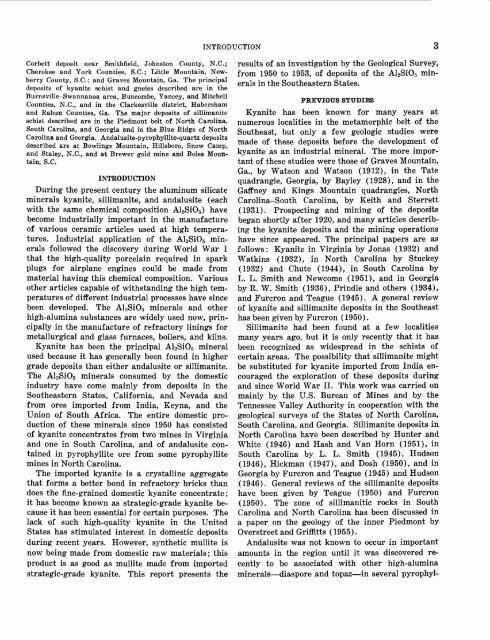Kyanite, Sillimanite, and Andalusite Deposits of the Southeastern ...
Kyanite, Sillimanite, and Andalusite Deposits of the Southeastern ...
Kyanite, Sillimanite, and Andalusite Deposits of the Southeastern ...
You also want an ePaper? Increase the reach of your titles
YUMPU automatically turns print PDFs into web optimized ePapers that Google loves.
INTRODUCTION<br />
Corbett deposit near Smithfield, Johnston County, N.C.;<br />
Cherokee <strong>and</strong> York Counties, S.C.; Little Mountain, Newberry<br />
County, S.C.; <strong>and</strong> Graves Mountain, Ga. The principal<br />
deposits <strong>of</strong> kyanite schist <strong>and</strong> gneiss described are in <strong>the</strong><br />
Burnsville-Swannanoa area, Buncombe, Yancey, <strong>and</strong> Mitchell<br />
Counties, N.C., <strong>and</strong> in <strong>the</strong> Clarkesville district, Habersham<br />
<strong>and</strong> Rabun Counties, Ga. The major deposits <strong>of</strong> sillimanite<br />
schist described are in <strong>the</strong> Piedmont belt <strong>of</strong> North Carolina,<br />
South Carolina, <strong>and</strong> Georgia <strong>and</strong> in <strong>the</strong> Blue Ridge <strong>of</strong> North<br />
Carolina <strong>and</strong> Georgia. <strong>Andalusite</strong>-pyrophyllite-quartz deposits<br />
described are at Bowlings Mountain, Hillsboro, Snow Camp,<br />
<strong>and</strong> Staley, N.C., <strong>and</strong> at Brewer gold mine <strong>and</strong> Boles Mountain,<br />
S.C.<br />
INTRODUCTION<br />
During <strong>the</strong> present century <strong>the</strong> aluminum silicate<br />
minerals kyanite, sillimanite, <strong>and</strong> <strong>and</strong>alusite (each<br />
with <strong>the</strong> same chemical composition Al2Si0 5 ) have<br />
become industrially important in <strong>the</strong> manufacture<br />
<strong>of</strong> various ceramic articles used at high temperatures.<br />
Industrial application <strong>of</strong> <strong>the</strong> Al2Si0 5 minerals<br />
followed <strong>the</strong> discovery during World War I<br />
that <strong>the</strong> high-quality porcelain required in spark<br />
plugs for airplane engines could be made from<br />
material having this chemical composition. Various<br />
o<strong>the</strong>r articles capable <strong>of</strong> withst<strong>and</strong>ing <strong>the</strong> high temperatures<br />
<strong>of</strong> different industrial processes have since<br />
been developed. The Al2Si05 minerals <strong>and</strong> o<strong>the</strong>r<br />
high-alumina substances are widely used now, principally<br />
in <strong>the</strong> manufacture <strong>of</strong> refractory linings for<br />
metallurgical <strong>and</strong> glass furnaces, boilers, <strong>and</strong> kilns.<br />
<strong>Kyanite</strong> has been <strong>the</strong> principal Al2Si0 5 mineral<br />
used because it has generally been found in higher<br />
grade deposits than ei<strong>the</strong>r <strong>and</strong>alusite or sillimanite.<br />
The Al 2Si0 5 minerals consumed by <strong>the</strong> domestic<br />
industry have come mainly from deposits in <strong>the</strong><br />
Sou<strong>the</strong>astern States, California, <strong>and</strong> Nevada <strong>and</strong><br />
from ores imported from India, Keyna, <strong>and</strong> <strong>the</strong><br />
Union <strong>of</strong> South Africa. The entire domestic production<br />
<strong>of</strong> <strong>the</strong>se minerals since 1950 has consisted<br />
<strong>of</strong> kyanite concentrates from two mines in Virginia<br />
<strong>and</strong> one in South Carolina, <strong>and</strong> <strong>of</strong> <strong>and</strong>alusite contained<br />
in pyrophyllite ore from some pyrophyllite<br />
mines in North Carolina.<br />
The imported kyanite is a crystalline aggregate<br />
that forms a better bond in refractory bricks than<br />
does <strong>the</strong> fine-grained domestic kyanite concentrate;<br />
it has become known as strategic-grade kyanite because<br />
it has been essential for certain purposes. The<br />
lack <strong>of</strong> such high-quality kyanite in <strong>the</strong> United<br />
States has stimulated interest in domestic deposits<br />
during recent years. However, syn<strong>the</strong>tic mullite is<br />
now being made from domestic raw materials; this<br />
product is as good as mullite made from imported<br />
strategic-grade kyanite. This report presents <strong>the</strong><br />
results <strong>of</strong> an investigation by <strong>the</strong> Geological Survey,<br />
from 1950 to 1953, <strong>of</strong> deposits <strong>of</strong> <strong>the</strong> Al2Si0 5 minerals<br />
in <strong>the</strong> Sou<strong>the</strong>astern States.<br />
PREVIOUS STUDIES<br />
<strong>Kyanite</strong> has been known for many years at<br />
numerous localities in <strong>the</strong> metamorphic belt <strong>of</strong> <strong>the</strong><br />
Sou<strong>the</strong>ast, but only a few geologic studies were<br />
made <strong>of</strong> <strong>the</strong>se deposits before <strong>the</strong> development <strong>of</strong><br />
kyanite as an industrial mineral. The more important<br />
<strong>of</strong> <strong>the</strong>se studies were those <strong>of</strong> Graves Mountain,<br />
Ga., by Watson <strong>and</strong> Watson (1912), in <strong>the</strong> Tate<br />
quadrangle, Georgia, by Bay ley (1928), <strong>and</strong> in <strong>the</strong><br />
Gaffney <strong>and</strong> Kings Mountain quadrangles, North<br />
Carolina-South Carolina, by Keith <strong>and</strong> Sterrett<br />
(1931). Prospecting <strong>and</strong> mining <strong>of</strong> <strong>the</strong> deposits<br />
began shortly after 1920, <strong>and</strong> many articles describing<br />
<strong>the</strong> kyanite deposits <strong>and</strong> <strong>the</strong> mining operations<br />
have since appeared. The principal papers are as<br />
follows: <strong>Kyanite</strong> in Virginia by Jonas (1932) <strong>and</strong><br />
Watkins (1932), in North Carolina by Stuckey<br />
(1932) <strong>and</strong> Chute (1944), in South Carolina by<br />
L. L. Smith <strong>and</strong> Newcome (1951), <strong>and</strong> in Georgia<br />
by R. W. Smith (1936), Prindle <strong>and</strong> o<strong>the</strong>rs (1934),<br />
<strong>and</strong> Furcron <strong>and</strong> Teague (1945). A general review<br />
<strong>of</strong> kyanite <strong>and</strong> sillimanite deposits in <strong>the</strong> Sou<strong>the</strong>ast<br />
has been given by Furcron (1950).<br />
<strong>Sillimanite</strong> had been found at a few localities<br />
many years ago, but it is only recently that it has<br />
been recognized as widespread in <strong>the</strong> schists <strong>of</strong><br />
certain areas. The possibility that sillimanite might<br />
be substituted for kyanite imported from India encouraged<br />
<strong>the</strong> exploration <strong>of</strong> <strong>the</strong>se deposits during<br />
<strong>and</strong> since World War II. This work was carried on<br />
mainly by <strong>the</strong> U.S. Bureau <strong>of</strong> Mines <strong>and</strong> by <strong>the</strong><br />
Tennessee Valley Authority in cooperation with <strong>the</strong><br />
geological surveys <strong>of</strong> <strong>the</strong> States <strong>of</strong> North Carolina,<br />
South Carolina, <strong>and</strong> Georgia. <strong>Sillimanite</strong> deposits in<br />
North Carolina have been described by Hunter <strong>and</strong><br />
White (1946) <strong>and</strong> Hash <strong>and</strong> Van Horn (1951), in<br />
South Carolina by L. L. Smith (1945), Hudson<br />
(1946), Hickman (1947), <strong>and</strong> Dosh (1950), <strong>and</strong> in<br />
Georgia by Furcron <strong>and</strong> Teague (1945) <strong>and</strong> Hudson<br />
(1946). General reviews <strong>of</strong> <strong>the</strong> sillimanite deposits<br />
have been given by Teague (1950) <strong>and</strong> Furcron<br />
(1950). The zone <strong>of</strong> sillimanitic rocks in South<br />
Carolina <strong>and</strong> North Carolina has been discussed in<br />
a paper on <strong>the</strong> geology <strong>of</strong> <strong>the</strong> inner Piedmont by<br />
Overstreet <strong>and</strong> Griffitts (1955).<br />
<strong>Andalusite</strong> was not known to occur in important<br />
amounts in <strong>the</strong> region until it was discovered recently<br />
to be associated with o<strong>the</strong>r high-alumina<br />
minerals diaspore <strong>and</strong> topaz in several pyrophyl-
















